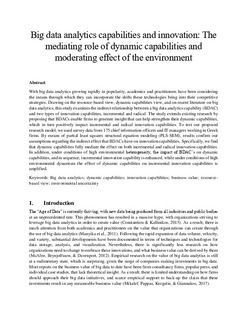| dc.contributor.author | Mikalef, Patrick | |
| dc.contributor.author | Boura, Maria | |
| dc.contributor.author | Lekakos, George | |
| dc.contributor.author | Krogstie, John | |
| dc.date.accessioned | 2019-12-02T14:34:34Z | |
| dc.date.available | 2019-12-02T14:34:34Z | |
| dc.date.created | 2019-08-08T12:13:43Z | |
| dc.date.issued | 2019 | |
| dc.identifier.citation | British Journal of Management. 2019, 30 (2), 272-298. | nb_NO |
| dc.identifier.issn | 1045-3172 | |
| dc.identifier.uri | http://hdl.handle.net/11250/2631308 | |
| dc.description.abstract | With big data analytics growing rapidly in popularity, academics and practitioners have been considering the means through which they can incorporate the shifts these technologies bring into their competitive strategies. Drawing on the resource-based view, dynamic capabilities view, and on recent literature on big data analytics, this study examines the indirect relationship between a big data analytics capability (BDAC) and two types of innovation capabilities, incremental and radical. The study extends existing research by proposing that BDACs enable firms to generate insight that can help strengthen their dynamic capabilities, which in turn positively impact incremental and radical innovation capabilities. To test our proposed research model, we used survey data from 175 chief information officers and IT managers working in Greek firms. By means of partial least squares structural equation modeling (PLS-SEM), results confirm our assumptions regarding the indirect effect that BDACs have on innovation capabilities. Specifically, we find that dynamic capabilities fully mediate the effect on both incremental and radical innovation capabilities. In addition, under conditions of high environmental heterogeneity, the impact of BDAC’s on dynamic capabilities, and in sequence, incremental innovation capability is enhanced, while under conditions of high environmental dynamism the effect of dynamic capabilities on incremental innovation capabilities is amplified. | nb_NO |
| dc.language.iso | eng | nb_NO |
| dc.publisher | Wiley | nb_NO |
| dc.title | Big Data Analytics Capabilities and Innovation: The Mediating Role of Dynamic Capabilities and Moderating Effect of the Environment | nb_NO |
| dc.type | Journal article | nb_NO |
| dc.type | Peer reviewed | nb_NO |
| dc.description.version | acceptedVersion | nb_NO |
| dc.source.pagenumber | 272-298 | nb_NO |
| dc.source.volume | 30 | nb_NO |
| dc.source.journal | British Journal of Management | nb_NO |
| dc.source.issue | 2 | nb_NO |
| dc.identifier.doi | 10.1111/1467-8551.12343 | |
| dc.identifier.cristin | 1714820 | |
| dc.description.localcode | Locked until 8.5.2020 due to copyright restrictions. This is the peer reviewed version of an article, which has been published in final form at [http://dx.doi.org/10.1111/1467-8551.12343]. This article may be used for non-commercial purposes in accordance with Wiley Terms and Conditions for Self-Archiving. | nb_NO |
| cristin.unitcode | 194,63,10,0 | |
| cristin.unitname | Institutt for datateknologi og informatikk | |
| cristin.ispublished | true | |
| cristin.fulltext | preprint | |
| cristin.qualitycode | 1 | |
